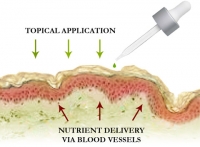Essential Nutrients For Healthy Skin
The skin is not only the largest organ in the body with approximately 20 square feet of surface area, but also a mirror of our health. Our skin is the first barrier protecting us from pathogens and pollutants. It has a critical role in regulation of body temperature and elimination of many metabolic waste products. The appearance of our skin can tell us about excessive exposure to sunlight or environmental pollutants. It reflects whether we have had too much stress, a lack of sleep, are dehydrated or have consumed too much caffeine, sugar, alcohol, or cigarette smoke. The skin can indicate problems with the digestive, cardiovascular, and nervous systems functions, as well as hormonal imbalances and inflammatory conditions. Most of us are concerned with skin appearance for cosmetic reasons but some skin problems including oily or dry skin, acne, wrinkles, or age spots are indicative of poor health of the skin and internal organs.
Good health starts with knowledge and if we want to take good care of our skin it is important to know more about this organ. The skin is composed of three main layers. The epidermis, the outermost layer, contains keratin and melanin to strengthen and protect us from harsh sun rays. The dermis, the second layer, is enriched with blood vessels, nerves, and collagen fibers essential for skin nourishment, oxygenation, and firmness and elasticity. The bottom layer, the hypodermis, contains fat cells to maintain body temperature. The epidermal layer does not contain blood vessels and therefore it relies on nutrients supplied from the dermis. Yet wrinkles, age spots and other unwanted changes are first visible in the epidermis. This tells us that in addition to oral supplementation, the topical application of nutrients is an effective way to directly supply nutrients to this layer of skin.
The firmness and elasticity of the skin depends on its main components - collagen and elastin. Therefore, reduced production of and increased destruction of collagen and elastin accelerate the symptoms of aging. Healthy skin also needs optimum production of glycosaminoglycans and hyaluronic acid present in the ground substance that binds the dermal and epidermal cells in the skin. Low hyaluronic acid content impairs skin hydration, its structure and elasticity, and the ability to repair itself. Age-related decrease in growth hormone production is reflected by dull skin because of the decreased production of new skin cells and the accumulation of dead cells on the skin layers. This also increases melanin pigmentation which accumulates in small pockets on the skin appearing as brown patches or “sunspots.” These “age spots” can also be promoted by deficiency of micronutrients such as vitamins C and E, and the amino acids proline, lysine and arginine.
We can support our skin in a natural way. Vitamin C together with lysine and proline are essential for producing healthy collagen, and together with vitamin E can reduce free radical damage. Vitamin C itself helps to reduce oxidative stress, improve the skin damage caused by UV rays and inflammation, and decrease the risk of melanoma. Moreover, topical application of vitamin C can strengthen the skin immune barrier and has an antihistamine effect which helps to reduce itching and other complaints of allergic skin conditions. Research shows that the skin responds well to topical application of certain nutrients. These include jojoba oil, aloe vera, geranium, and dandelion extracts, and others that nourish the skin and have antioxidant properties making it appear youthful and healthy. While a healthy diet is critical for healthy skin, the topical application of specific natural compounds may provide extra support for a healthier and younger looking skin.
